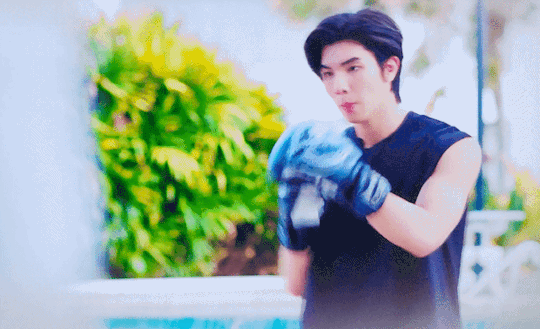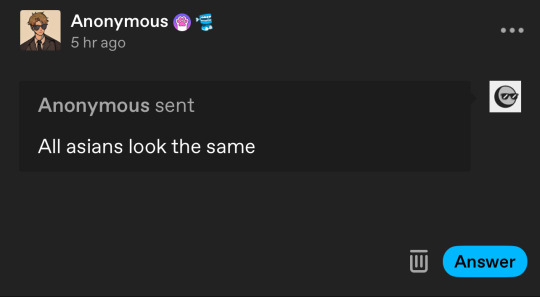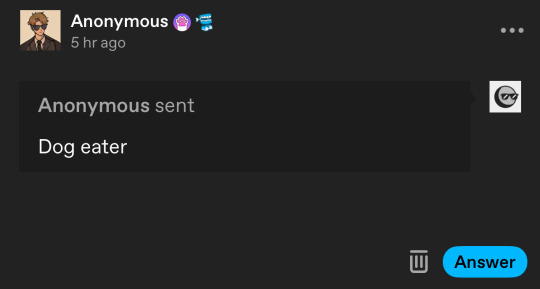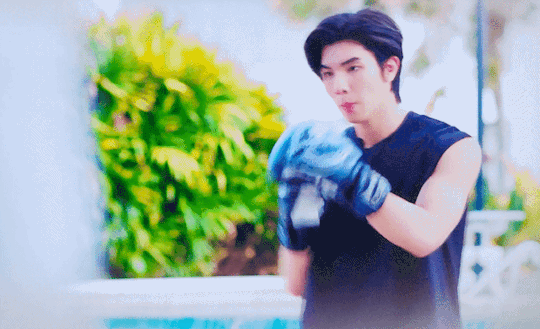#SINGAPOREAN-THAI
Explore tagged Tumblr posts
Text






LEE LONG SHI
[Nickname: LONG]
#BAM (BEAUTIFUL ASIAN MEN) POST#My GIFS#MYGIFSET#MyGIFedit#ACTOR#BL ACTOR#FORMER MUAY THAI TRAINER#SINGAPOREAN-THAI#FATHER IS SINGAPOREAN#MOTHER IS THAI#LOVE ADVISOR#I AM YOUR KING 2#BANGKOK: MINI SERIES#THAT'S MY CANDY#EVEN SUN#TIN TEM JAI#BAD SOCIAL#BEAUTIFUL/GORGEOUS MEN#BAM#HE IS A HOTTIE
9 notes
·
View notes
Text

Crispy Thai Basil Pancakes / Zhua Bing 九層塔抓饼 (Vegan)
#vegan#breakfast#appetizer#Chinese cuisine#Malaysian cuisine#Singaporean cuisine#southeast asian cuisine#East Asian cuisine#savory pancakes#pancakes#thai basil#Chinese 5 spice#coconut sugar#sesame oil#sea salt
30 notes
·
View notes
Text




Seasian4Seasian (Southeast-Asian4Southeast-Asian
- Not for RCTA people.
- Requests open!!
- Seasian4Seasian : SouthEast Asian ppl who prioritize/prefer/only date other SouthEast Asian ppl.
- FLAG ID : 7 striped flag, with an Dusty Red Orchid in the middle.
- COLORS : Dusty Blue, Steel Blue, Dusty Red, Pale Red, Dusty Red, Steel Blue, Dusty Blue.
- EXTRA : The colors were chosen due to many Seasian flags having Red and Blue in them. The flower is a Orchid which are revered for their beauty and diversity. Along with holding cultural significance is places such as Malaysia, Thailand, and Indonesia.



#🍤 !! Jiaming's Coining.. -𝄡#south east asian#asian4asian#asian#x4x flag#x4x#southeast asian#south-east asian#vietnamese#filipino#indonesian#malaysian#burmese#singaporean#laotian#cambodian#thai#hmong#flag#flags#poc4poc#orchid#flag coining#flag making#mogai flag#pride flag
22 notes
·
View notes
Text
not to be all emo & shit but off being THE STAR of the kenzo paris event ABROAD is making me go 🥺😭 like my man is really going inter huh 🥰
#off jumpol#thai actor#gmmtv#byofftay#2023#literally not to be that bitch but he has 4 million followers more than the other celebs at the event & really was the star of it#even singaporean outlets made it all about off I'm so fucking proud 😭
19 notes
·
View notes
Text
Okay. The Promise IS REALLY GOOD, SO GOOD, SO GOOD! Gah, I am SO happy I picked this up.
Episode 3: we still don’t have a read on what separated Phu from Nan for 10 years. However, a few notes on why this episode was the best yet so far, despite not getting that juice yet. Some quick notes first, and then big thoughts (and I have a couple of coffee notes as a postscript):
I should have realized this earlier, but I think one reason why I’m loving this show so far is because, while much of the show is flashbacks, our two mains are in their early-going-into-their-mid-30s, and much of the show happens in the context of their professional pursuits. As an #old, me likey -- I always love generational shifts in dramas, and I definitely need more dramas with older folk.
The sponsorship of this show is so wild, but honestly, I’m not kidding, I kinda think it works (listen, it looks like UMG’s only sponsor is for for CANNED MACKEREL, so like, how they’re going to weave CANNED MACKEREL in the show will be VERY INTERESTING, and I’m NOT looking forward to it). Why does this Devonte Men skincare framework shit work?
Because: this episode focused on Nan as a professional. And I LOVED IT. In his personal life, Nan’s a mess. Before Phu came back, he had trouble sleeping, his house was in disarray. During college, he needed to rely on Phu to keep track of his classes. Phu keeps Nan in check -- he encourages Nan to keep fit, Phu keeps Nan organized.
But in the office? We see that at least in this episode, Nan’s a G, a confident one, too. I can’t wait to get @respectthepetty‘s read on Nan’s red suit vs. the blue suit at the end, but I totally felt the red rascal vibe on Nan for the first three quarters of the show. Nan owned everything! He HUSTLED and GOT THE COFFEE SHOP FOR PHU. He nailed the first presentation with boss Ken. Nan was faltering a touch at the end, but HIS bro (not anyone else’s bro) came thru with the product samples and the dimples. Nan makes shit happen professionally -- for himself, for his team, for Phu. We didn’t get quite that strong sense during the first two episodes, but this episode clearly defined what Nan can do STRONGLY in his life. He’s not a total hot mess.
I LOVED THIS. We know we need to learn about Phu, but Uncle Tong Khom Kongkiat is out here telling us -- there’s a story, a big story, about Nan, too, that I need to tell y’all, so that y’all have the full context you need to understand what’s happening between these two.
And that’s why those small flashbacks to Chiang Mai and to Nan’s dad were really important. Phu and Nan, Nan and Phu -- they’ve balanced each other out for their lives. They clearly exist in an equilibrium when they’re together, and it’s so lovely to watch. I looooved that tingle of jealousy at Joe’s club, and then the ride home. It sizzled.
When Phu was out of Nan’s life, Nan was unbalanced. I think episode 3 makes sense as Nan’s presence as a professional is depicted as so strong, because Phu is back in his life, and Nan is back in balance.
I THINK THIS SHOW IS SO GREAT. (I totally don’t mind the whole weaving-in of the sponsorship thing. They make it work.)
****
Okay, quick SE Asian food/coffee thoughts (y’all know I love the food context), because I actually think they’re important to the show. I could maybe make a separate post about this, à la khao man gai, but let me just put this down first. Coffee is VERY important to this show, clearly.
Oliang means coffee! Oliang is specifically Thai black iced coffee, according to Wikipedia. Man, my heart. I love that Nan named his cat Oliang. A way to honor how he missed Phu, the coffee guy, before Phu came back.
Okay, I don’t know that much about this, but it seems that a common way to brew coffee in Thailand is to brew it with spices, which, GAH, YUM. (I once had a drink here in the States called “Bangkok iced coffee,” which was cardamom-infused coffee with half-and-half and condensed milk. GOOD LORD.) Check the Wikipedia article for the different styles of iced coffee you can get in Thailand -- oh my fucking god, YUM.
Alright, kopi. (Peep the definition for Thai kopi in the oliang article linked above.) I love that Thai and Malay both share a same word for kopi, although Malaysian/Singaporean kopi looks like it’s slightly different than in Thailand, because there are many styles of “kopi” in M’sia/SG that don’t necessarily come with condensed milk. Take a look at this list on the Malaysian/Singaporean kopi Wikipedia page.
I also don’t *think* that Malaysian/Singaporean kopi is boiled with spices (if they don’t mind the tag, my SE Asian homies @telomeke and @tireddddddddddddddd-d might know -- apologies for tagging you if you’re not watching The Promise, but kopi question over here! Is Malaysian/Singaporean kopi ever boiled with spices, as it seems to be in Thailand?)
If you’re a coffee nerd: note that in the Malaysian/Singaporean style of kopi, that the beans are roasted with salt, sugar, and margarine. There’s a style of coffee in M’sia called Ipoh white coffee, which is my personal fave, super strong, and seriously divine, if you ever get your hands on it. It’s famous in part for that roasting in margarine.
It seems that, according to the kopi Wiki article, that the kind of Thai kopi that Nan and Phu drink was actually historically inspired by the Malaysian/Singaporean way of roasting and brewing hot coffee. So putting it all together, the Thai kopi that Nan and Phu have seems to be the hot spiced coffee with condensed milk, which must be just HEAVENLYYYYYYY. Gah. (And I love love love how they reference it as “old-school coffee.” A throwback to their rural childhood.) (I am sure many of y’all have had strong Vietnamese coffee, which is also black coffee with condensed milk.)
ANYWAY. Coffee/kopi culture is big in this region, and so worth nerding out about! Anytime I can get my hands on Malaysian kopi/white coffee, I get it, and I’m certainly going to keep my eyes peeled for Thai coffee preparations now. If I’m ever lucky to get my hands on a cup of old-school Thai kopi, I’ll report back on how awesome I know it will be.
#the promise#the promise meta#nan x phu#phu x nan#khom kongkiat#thai coffee#kopi#thai kopi#malaysian kopi#malaysian coffee#singaporean coffee#singaporean kopi#coffee culture#kopi culture
21 notes
·
View notes
Text

MAN CRUSH FANDOM ▪︎ MADE IN THAILAND
LEE LONG SHI
[Nickname: LONG]
#Man Crush Fandom#Made in Singapore/Thailand#My GIFS#From My Main Blog: BL-BAM-BEYOND#Singaporean & Thai Actor#Gorgeous#I AM YOUR KING 2 (2019)#BANGKOK (2020) Short Story#THAT'S MY CANDY (2022)#EVEN SUN (2022)#TIN TEM JAI (2023)#LOVE SYNDROME 3 (2023)#GIFS by ME#BAM Candidate
2 notes
·
View notes
Text
Singaporean Arrested for Bomb Hoax targeting an AirAsia flight at Bangkok Airport
A Singaporean man, identified as “Mr Ho,” was arrested for making a false bomb threat targeting a Thai AirAsia flight at Bangkok’s Don Mueang International Airport. The incident, which occurred Thursday, delayed Flight FD 3114 to Hat Yai, disrupting 162 passengers and six crew members. Ho, who overstayed his visa by 28 days, confessed, citing family stress. He faces prosecution under Thailand’s…
0 notes
Text
Shoutout to all Asian LGBTQ+ folks.
Shoutout to all Bruneian LGBTQ+ folks.
Shoutout to all Burmese LGBTQ+ folks.
Shoutout to all Cambodian LGBTQ+ folks.
Shoutout to all Filipino LGBTQ+ folks.
Shoutout all Hmong LGBTQ+ folks.
Shoutout to all Indonesian LGBTQ+ folks.
Shoutout to all Laotian LGBTQ+ folks.
Shoutout to all Malaysian LGBTQ+ folks.
Shoutout to all Mien LGBTQ+ folks.
Shoutout to all Singaporean LGBTQ+ folks.
Shoutout to all Timorese LGBTQ+ folks.
Shoutout to all Thai LGBTQ+ folks.
Shoutout to all Vietnamese LGBTQ+ folks.
Shoutout to all Afghani LGBTQ+ folks.
Shoutout to all Armenian LGBTQ+ folks.
Shoutout to all Azerbaijani LGBTQ+ folks.
Shout to all Georgian LGBTQ+ folks.
Shoutout to all Kazakh LGBTQ+ folks.
Shoutout to all Kyrgyz LGBTQ+ folks.
Shoutout to all Mongolian LGBTQ+ folks.
Shoutout to all Tajik LGBTQ+ folks.
Shoutout to all Turkmen LGBTQ+ folks.
Shoutout to all Uzbek LGBTQ+ folks.
Shoutout to all Chinese LGBTQ+ folks.
Shoutout to all Japanese LGBTQ+ folks.
Shoutout to all Korean LGBTQ+ folks.
Shoutout to all Okinawan LGBTQ+ folks.
Shoutout to all Taiwanese LGBTQ+ folks.
Shoutout to all Tibetan LGBTQ+ folks.
Shoutout to all Bangladeshi LGBTQ+ folks.
Shoutout to all Bhutanese LGBTQ+ folks.
Shoutout to all Indian LGBTQ+ folks.
Shoutout to all Maldivians LGBTQ+ folks.
Shoutout to all Nepali LGBTQ+ folks.
Shoutout to all Sri Lankan LGBTQ+ folks.
Shoutout to all Pakistani LGBTQ+ folks.
Take pride in it all. Your culture, your identity, it’s all so beautiful. Celebrate where you are from and who you are. It makes you you, and that is something to be proud of.
post for Pacific Islanders, post for Middle Easterners, post for Oceanic folks , post for Hispanics, post for Africans, post for Native Americans, post for Caribbeans
#mental health#positivity#self care#mental illness#self help#recovery#ed recovery#pro recovery#actuallytraumatized#actually cptsd#lgbt#lgbtq#lgbtq representation#lgbt positivity#lgbtqia#lgbtq positivity#lesbian#gay#bi#bisexual#trans#transgender#Asia#Asian#pansexual#asexual#aromantic#transmasc#transfem#nonbinary
3K notes
·
View notes
Text





LEE LONG SHI
[Nickname: LONG]
#POST: BAM (BEAUTIFUL ASIAN MEN)#SINGAPOREAN-THAI ACTOR#FORMER MUAY THAI TRAINER#CRAZY HANDSOME RICH#ROM COM#DUBBED?#My GIFS#MYGIFSET#MY-GIF-EDIT#THIS MAN IS EFFING GORGEOUS
17 notes
·
View notes
Text


Kue Cucur Jawa / Khanom Fak Bua / Pandan Pancakes (Vegan)
#vegan#desserts#thai cuisine#indonesian cuisine#malaysian cuisine#singaporean cuisine#southeast asian cuisine#rice flour#pandan#coconut water#palm sugar#coconut oil
40 notes
·
View notes
Text
NEW SIGNING ALERT!!!

I am extremely pleased to announce that Singaporean (now based in Phuket, Thailand) acoustic/blues/jazz artist Mellow Blues is now part of the HHR family, with his latest album The Phuket Session now available on the HHR Bandcamp.
Inspired by Southeast Asian tropical vibes, Mellow Blues is a Singaporean jazz, blues and bossa nova solo acoustic guitarist, singer and songwriter living in Phuket, Thailand. His musical style is centered in the blues with explorations in bossa nova and jazz and sounds like Sixto Rodriguez and Carlos Santana performing as a duo.
Listen to and purchase the album at the link below. All sale proceeds go directly to the artist as always with HHR.
Remember to always support emerging artists!
#blues#blues music#acoustic#jazz#bossa nova#samba#thai music#singaporean artist#thai artist#heritage harmony records#Bandcamp
1 note
·
View note
Text
Hello! This is a message to the anon who has been sending very haphazard, messy and increasingly nonsensical hate. They are pretty ew.
Not sure if cringe anon is the same as this one, but if you are, here’s a quick thingy. Sure, I’ve played with your message, adding humour as a lovely way of mockery to you. But there is a line to be drawn, I’m fine with you making snarky comments. I make snarky comments, but I draw the line when you start insulting whole groups of race. And….insulting us with the most generic types of comments.

Seriously?
That is the most ridiculous pseudo hate ever.
I’ll remind you that the term “asians” include Chinese, Korean, Japanese, Thai, Viet, Malaysian, Singaporean, Filipino, Indonesian, Saudi Arabian, Indian, Bhutanese, Pakistani, Lebanese and so many more groups of people.
You’re gonna have to be the most dumb, blind and ignorant piece of filth if you think all of those groups of people look the same. If you really believe that, you’re bigoted and ill informed.
Also. OF COURSE SOME GROUPS OF PEOPLE WHO HAVE A COMMON ANCESTOR LOOK THE SAME, OH MY GOD THE STUPIDITY!
And if you are part of Asia and you’re gonna whine like “I was just making a joke!” This is not a joke if it hurts people, yes this is a popularised statement but to many people, it is not funny. It is only a joke when EVERYONE is laughing. So shut up about that.
And then here

….that’s just so wrong.
First of all, I’m ethnically Chinese, which means my great grandparents originally came from china. I was not born on the mainland, nor was my parents, nor was my grandparents. And where I am currently living, consumption of dog meat is illegal. Even in China, the amount of dog meat consumption is drastically decreasing.
That is an old, outdated, stereotypical, insulting way to refer to Chinese people. Not only that!
You also might refer to people from Cambodia, India, Indonesia, Ghana, Laos, Vietnam, Nigeria and Switzerland. Unless you’re saying I’m from all of those countries, your statements makes no fucking sense.
I’ll wrap it up, in the end, I may laugh, joke around, make fun of such comments, but I draw the line when it could potentially hurt bigger groups of people.
My blog is a place to talk to my friends, I’ve made many good ones here, Mireya, Zahrawr, Tanaka, Jeah, Riyana, God, Tamanna, Etc
To all of you, I’m very grateful for getting to meet you.
To this Anonymous person: if you come out and say “oh it’s just a joke” or reveal that you are Asian too, shame on you. Out of all people, you should know how bigoted and disgusting those statements are. If you aren’t asian, even worse. You’re a stupid, ignorant and pathetic piece of shit who thinks it’s okay to send these types of messages. You disgust me.
Moving on, I will not tolerate any more of these types of posts, I will be deleting them on sight. I won’t be turning off anon, since there are lovely anons who like to send nice messages. But I will not be posting anymore of these stupid, idiotic and hateful comments, especially that could potentially hurt a large number of people.
Fuck off, leave all these people alone, leave me alone, this is not a joke, it’s not okay to be spout this bullshit so freely.
Update: I’ve blocked anon ;)))
If this turns out to be anyone I’ve tagged, I will be very very disappointed in you.
@jeahreading @tamanna-and-her-struggles @shinchansbitch @im-on-crack-send-help @iamgayforyourmom1510 @mentallyunstablequeen101 @momhwa117 @zeherili-ankhein @your-dazzling-sun @schrodinger-ka-billa @abyssmita @cafffeineconnoisseur @byproduct-of-hades @lotuseaterwhowistlesthedark @mireyaaaaaaaaa @circe-butbetter @mi-stress-of-chaos @lyrebirb @depressed-bi-twerking @hershey-not-the-chocolate-maybe @lesbianpoetess @unhinged-as-hell @debacleofdaemons @sunshinerainbowsandlollipops @celesteablack @evry1h8s-me @transienctly-translucent @priimadonnna
#ps#if i do receive anymore of these and they start being threats I can and will turn off the anonymous features#fuck you anon#fuck off and fuck you#i would be lying if i said I wasn’t pissed#because I’m pissed and annoyed#way to start the day huh???#leave everyone alone#and if you are one of us you seriously disappoint me#I hope you shut up and take some reflection time#anyways anyone who’s reading this and triggered I’m so sorry#i love yall/plat
115 notes
·
View notes
Text





MCF: MADE IN SINGAPORE/THAILAND
LEE LONG SHI
#MAN CRUSH FANDOM#MADE IN THAILAND (SINGAPORE)#From My Main Blog: BL-BAM-BEYOND#BAM CANDIDATE#SINGAPOREAN/THAI ACTOR#MUAY THAI FIGHTER/TRAINER (FORMER)#My GIFS#MYGIFSET#MY-GIF-EDIT
0 notes
Note
Svt & learning to cook food from s/o’s homecountry (aka not korean food). A different culture & food for each member would rlly cool
making you a meal from your country
content: established relationship, fluff, foreign reader (non-korean), etc.
wc: 872
a/n: this was such a cute concept omg!! i picked the food items and the home countries at random btw sorry if i got some dishes wrong pls lmk if there's any corrections i should make 😭
masterlist
seungcheol -
he wouldn't be able to stand your homesickness for even one second, feeling too sad at your sadness and deciding to do everything in his power to make you feel better. he'd ask around for traditional south african dishes leading him to make you some chakalaka while you were at work. the hours of trial and error wouldve been worth it the moment he saw the happiness in your eyes at his efforts.
jeonghan -
being quite used to simply ordering takeout whenever he so pleased, jeonghan was not used to cooking at home too often. however, if his sweet s/o wanted some homemade tom yum soup, then he'd deliver! after a quick call to mingyu (and an hour or two of messing around in the kitchen), he'd be ready with your food. he loves thai food, so this would be a win-win situation for him.
joshua -
he knew you sometimes missed australia and were unable to go back and forth as you pleased, so josh would occasionally indulge you in making meat pie for you, following a recipe you'd once made for him early in your relationship.
jun -
he'd had indian food before and loved it, so it did not take any convincing for him to decide to make you some indian street food. he'd do it out of his own volition pretty often, actually. by now, he had mastered the art of various dishes, specially panipuri, which he would frequently make for you, and sometimes he'd even share some with his members.
soonyoung -
if he sensed you growing homesick and missing your usual chinese cuisine, he'd go out of his way to seek out jun or minghao to ask what food may make you feel a bit better. he'd then take on the task of making you the most delicious street breakfast, jianbing, knowing it wasnt too difficult a task for him and that it was a meal you'd often have in your youth.
wonwoo -
wonwoo was quite known for his lack of ability in the kitchen, but that would not stop him from making you some laksa whenever you were feeling particularly homesick. despite not knowing how to make any other singaporean dishes, he'd have specifically mastered at least one in order to take care of you in such a domestic way whenever the opportunity arose.
jihoon -
never having been one to cook much (he'd much rather stick to washing dishes), he'd struggle a lot through making you some pastéis de nata for your anniversary, deciding to make a korean-portuguese fusion of meals to celebrate your relationship. ok, maybe he called mingyu over to help, but the joy in your eyes as you shared the meal with him had made it worth all of mingyu's nagging as he followed his instructions to the letter.
seokmin -
he's never been to spain, but he's had a few spanish meals throughout his life, so he'd quickly understand why you'd often complain about the lack of authentic spanish food near your shared apartment. would take it upon himself to learn how to make paella in the most perfect manner imaginable just to see a smile on your face.
mingyu -
making a pizza from scratch was easier said than done, but mingyu had taken on the task the moment you let him know of the fomo you felt at seeing him and his best friends explore your country of origin, italy. you'd watched nana tour happily, but still felt a bit off at knowing you couldn't be there with your boyfriend. but fear not! mingyu was about to bring the authentic italian experience to your door!
minghao -
he's been to the united states so many times by now that he just knows american food by heart. wouldnt even need a recipe to know how to make you some classic barbecue on a sunny afternoon. would even make an entire day out of it, grilling under the sun while you sunbathed next to him.
seungkwan -
seungkwan has always thought himself to be quite a good cook. or at least he was quite good at making korean food. japanese food was another story. he knew how badly you missed homemade sushi, never enjoying any from your nearby restaurants. he'd have to ask for your help at some point, but the end result would be the two of you sharing a nice moment making a meal together, so it all went according to plan.
vernon -
he doesnt know how to cook neither korean nor american food, but you best bet he'll try his hardest to make you traditional vietnamese food in the form of bun cha and bánh xèo. it looked easy and like it tasted good, how hard could it be? would try his bestest but eventually need to ask you for help completing the task. a+ for effort, though.
chan -
he already loves mexican food, so making it for you wouldnt even be something you'd have to request from him – he'd just do it on his own! he'd already mastered all types of street food, eventually opting to make you menudo, knowing how much you enjoyed that meal as a child.
#seventeen fanfic#seventeen x reader#svt fanfic#svt x reader#seventeen#seventeen imagine#svt#seventeen oneshot#svt reactions#seventeen reactions#svt scenarios#seventeen scenarios#svt imagines
323 notes
·
View notes
Text

Thai!Cosette and Singaporean!Marius enjoying a few snacks out and about ^^

unfortunately Marius inhaled it a bit too fast 😔
Read more to see the food I was inspired by!
Cosette is eating a curry puff/epok-epok, a small pie filled with curry and usually chicken and potatoes. A lot of varieties in SEAsia regarding its fillings!

Marius is eating moo ping, which are Thai grilled pork skewers!

They are both drinking Thai milk tea and Thai green milk tea; Cosette's is served in a plastic bag with a straw, which is how its often served in SEAsia!


The background is vaguely inspired by the pasar malam (night markets) in my country, basically a temporarily-erected street market. They appear for a few days every so often, usually around festivities! So I'd think they would have found some markets during the CNY period and visited them :DD

#to the anon who sent me about filipino marius: its coming!!#i just have sg!marius in the drafts for a while now :3#this is CNY related. to me. 🤭#nothing beats celebrating holidays in SG by rolling up to a pasar malam and getting overheated by the crowds#am now craving for pasar malam food#les mis#les mis fanart#cosette#cosette fauchelevent#marius pontmercy#syrup art tag
73 notes
·
View notes
Text




PETRICHOR CAST ROYALTY
👑 Engfa Waraha Miss Grand 2022 Winner 👑 Charlotte Austin Miss Grand 2022 5th Runner Up 👑 Meena Rina Miss Grand 2023 5th Runner Up 👑 Malin Charaanant Miss Grand 2024 Winner
Random facts under the cut
Engfa also finished 1st Runner up in Miss Grand International 2022 and Malin placed in the Top 20 for Miss Grand International 2024.
Meena is also 1/2 of the MeenBabe ship with the Miss Grand Thailand 2023 winner Aoom Thaweeporn. They'll star as a secondary couple in the 2025 Y Entertainment upcoming gl drama About Galaxy.
Charlotte is Thai-British, Meena is Thai-Iranian, and Malin is Thai-Singaporean.
Engfa is a professional singer and Meena is a professional ballroom dancer (please look up videos of Meena dancing)
Meena has a LOT of tattoos on her back, side, and leg
#just a brief info dump for new fans love these girls :)#in case everyone was wondering why theyre so beautiful#also do yourself a favor and look up meena's dance during the swimsuit competition#petrichor the series#petrichor cast#englot#engfa waraha#charlotte austin#tulran#tul chanwimol#cherran trakulwipatkul#malin charaanant#lin malin charaanan#malin chara anan#may suwitthaya#meena rina#meena chatamonchai#jiu ansaya phianwaja#jiwmay#jiumay#about galaxy the series#meenbabe#aoom thaweeporn#miss grand thailand#mgt#mgi
110 notes
·
View notes